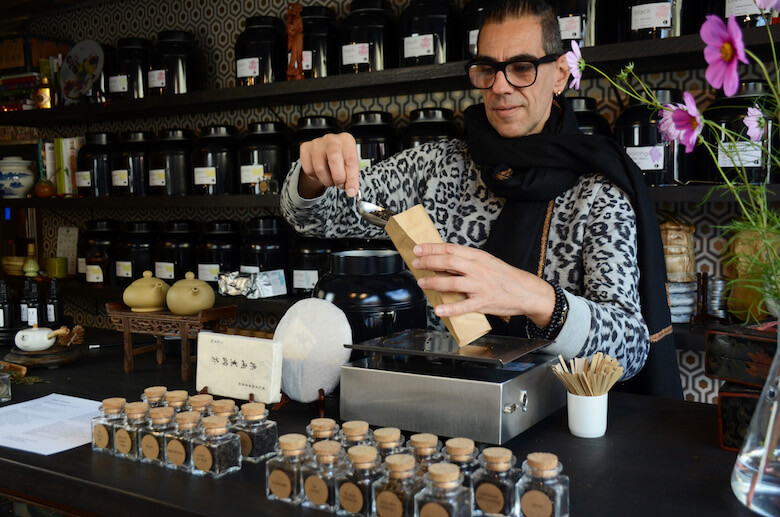
“Hello, would you like some tea?”
Ducking inside from the rain, I looked around the small mezzanine surrounded by canisters filled with exotic teas, beautiful ceramic tea vessels and carefully wrapped cakes of compressed tea leaves. I had just entered Puerh Brooklyn and specialist Brandon Debidin made me feel welcome.
The Grand Street shop brews and sells teas from all over the world alongside snacks (think raw chocolates and matcha cookies), modern and vintage teaware and a curated selection of tea-focused books. Workshops, classes and ceremonies—some led by visiting tea masters from across Asia—are also on the docket. It’s one of the few tea shops in the city that sources far and wide while specializing in hard-to-find varieties.

I was specifically interested in the shop’s namesake “pu-erh,” an aged and fermented tea from China’s Yunnan province. Often used as a digestive, there are ripe and raw varieties; the former means that the leaves have been moistened to hasten the aging process that takes a few months while the raw variety is made from leaves that have been allowed to age and ferment on their own over several years. Over time, its flavor evolves as different bacteria and fungus grow on the leaves to produce a rich and mellow but still powerful tea prized for its health benefits and complex flavor.
Brandon took out a large raw pu-erh cake of Da Xue Shan Wild Arbor, its name signifying that it comes from wild trees in Da Xue Shan (a high mountain in the Yunnan). Using a small metal pick and poking it into the side of the cake, he carefully released some of the compressed leaves that he then placed into a tiny, traditional clay yixing teapot about the size of a tennis ball.
“These little guys are more than just a teapot, they’re something you treasure,” Brandon explained. I learned that they are small for multiple steepings, to facilitate tasting the tea at different levels of strength and flavor.

“As the steepings go on, you’ll notice an increase in all the different compounds, in all the different aspects of the tea,” Brandon told me after our first steeping, which tastes quite strong and bitter. “The second and third steeping get better, the fourth is even better, and then it reaches a climax and starts slowly coming back down. With each steeping, you’ll still get something new going on.”
Indeed, with each new infusion comes a whole new flavor. I liked the third best; it’s potent (I felt a buzz from the caffeine) and floral but not too bitter.
Grippo, the owner of Puerh Brooklyn and an Argentinean artist and fashion designer, also joined us. The lower level of the shop serves as his atelier and showroom as well as an exhibit space for other artists who mostly focus on teaware.

“Since I got into this space six years ago I always wanted to do something upstairs,” Grippo said. “But then suddenly every shop you walked into in Williamsburg had an espresso bar, so I was like, that’s already gone.”
He and his husband and co-owner Werner Morath had the idea for the tea shop when an assistant gave Grippo a teapot for his birthday.
“The whole idea of opening a tea shop was, first, because I wanted to have a place where people in the neighborhood could source good-quality teas at a price that was reasonable,” Grippo said. “And the second was that I liked that [so many cultures have] a different ritual around tea, or drinks that they call tea, and that they gather and drink together…. I liked that component of something multicultural.”
Brandon asked me if I want to try the 10th steeping. By now, the tea was pale green and tasted almost of water. “The best way to learn anything about tea is to just drink it,” he said as I took my last sip.
Photos courtesy of Puerh Brooklyn.



